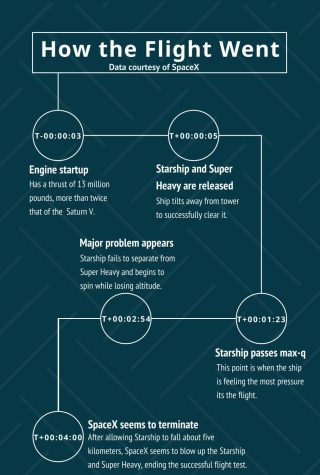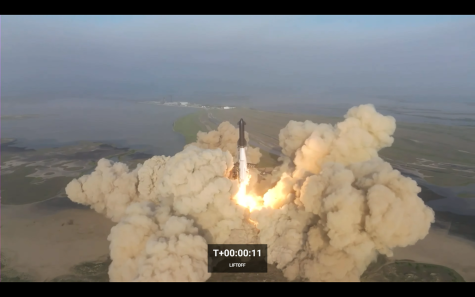On April 20 at 6:33 a.m., SpaceX launched its Starship rocket from a remote site in southern Texas. According to SpaceX’s founder and CEO Elon Musk, Starship is the tallest and most powerful rocket ever built, and SpaceX hopes it can one day become a vehicle for interplanetary travel. This launch was Starship’s first uncrewed test flight.
Starship was supposed to separate from its booster and splash down near Hawaii after a 90-minute, sub-orbital flight. However, the rocket exploded midair shortly after takeoff, before the Starship had separated from its booster. The entire rocket then fell into the Gulf of Mexico.

Trouble was evident as soon as the vehicle launched when six of its 33 engines did not fire. Then, Starship did not separate from its booster at approximately two and a half minutes after liftoff as planned. Shortly afterwards, the rocket started rotating in circles and tumbling back toward Earth and exploded four minutes after take off. At its highest point, Starship reached 24 miles above the Earth’s surface.
Standing at 390 feet tall, the Starship rocket consisted of a first-stage booster (the “Super Heavy”) and a second stage (the “Starship”). The second stage will function as a self-contained spacecraft for carrying crew or cargo into orbit in the future. Both stages were powered by Raptor engines that burned liquid oxygen and liquid methane propellants in a highly efficient full-flow staged combustion power cycle.
Although the trip did not go as planned, it provided valuable information for SpaceX to make the Starship fully operational in the future. Just getting this massive rocket off the launchpad was seen as a major accomplishment by NASA, among others. After the explosion, Musk tweeted that SpaceX team members had “learned a lot for the next test launch in a few months.”
Despite its unsuccessful outcome, there was no lack of enthusiasm and interest in this historic launch at Redwood. Redwood’s Astronomy Club members and its advisor echoed the “excitement guaranteed” sentiment in Musk’s pre-launch tweet.
“It was a pretty cool thing to watch this amazing feat of engineering,” said senior club member Bayanni Rivera.
“Rocket launches are so beautiful — the vapor, the excitement,” science teacher and advisor Elise Rubio said. “The really slow build-up of velocity is super exciting to watch [as it’s] happening.”
Future Starships are expected to be reusable and will return to Earth by landing vertically, or using a “drone ship,” as the first stages of SpaceX’s Falcon 9 and Falcon Heavy rockets already commonly do.
Once Starship is fully operational, it will initially be used to launch satellites into low Earth orbit before flying with crew. With its size and power, Starship could lift as much as 250 tons and carry 100 people to Mars. SpaceX hopes to one day have Starship transporting crew and cargo to the moon and Mars. Redwood’s astronomy community expects Starship to reach its goals.

“I would certainly go to the moon or Mars [on Starship],” said Rivera. “And of course Starship will be successful. SpaceX has made steady progress ever since inception. This is a step forward, and it’s progress. Eventually they’ll get it right.”
Rubio agrees that the Starship will make it to the moon and beyond. “Those [SpaceX] engineers are at the top of their game and there are so many of them,” said Rubio. “They have the brightest, youngest and most creative minds working for them, so I absolutely think they will nail this.”







